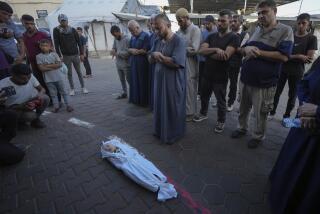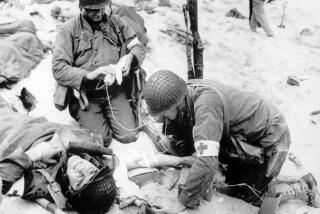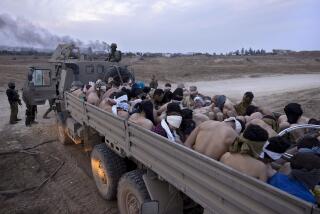Troops Outracing Medical Network : Logistics: Supplies have reached rear staging areas, officials say, but not all forward combat hospitals.
EASTERN SAUDI ARABIA — American soldiers and Marines are moving so rapidly and in such huge numbers as they reposition themselves along the front, they are running ahead of crucial medical supplies to treat casualties.
The Army Surgeon General’s Office says it has caught up with and “corrected” the persistent problem insofar as getting necessary supplies and equipment to rear staging areas of the war zone--but not always to the forward combat hospitals.
And still, as throughout the six-month military buildup, unsettling reports continue to swirl through the Gulf region about hospitals and medical aid stations not being fully prepared for battlefield casualties.
The Army’s 13th Evacuation Hospital, for instance, is critically short of something as basic to trauma medicine as intravenous fluid, used to treat shock and blood loss.
The hospital was improvising by formulating its own IV fluid, using bottled drinking water, table salt from field ration packets and a measure of antibiotics.
“That’s the closest to sterile that we’re going to get here,” said Col. Guenther Pohlmann, a physician from Milwaukee. He pointed out that if wounded troops “get a fever, that’s not going to kill them.”
Then, too, only one of every six beds at the post-op recovery room was equipped with a ventilator, an important piece of equipment used to assist the breathing of patients with chest-lung wounds.
Again, the hospital was planning to improvise: to train everybody in the camp, from mechanics to ambulatory patients, in techniques of manual ventilation. Another alternative, hospital staffers said, would be to rotate ventilators bed to bed as needed.
Virginia Stephanakis of the Army Surgeon General’s Office said that the problem may be one of expectations as much as supply.
“Many doctors have never been in a combat situation before,” she said. “They are coming from very sophisticated hospital situations. The combat situation, by comparison, is very austere. They are not going to have a ventilator at every bed. But they probably don’t need a ventilator at every bed.”
Overall, Stephanakis said, medical equipment and supplies shortages are not as bad as earlier in the campaign.
“We don’t think that it’s a serious problem,” she said. “At the beginning, it was a problem; it was an enormous logistic effort to get everything over there.”
But now, Stephanakis added, “We are fairly confident that everything that is necessary is somewhere in Saudi Arabia. It is just a question of getting the items to the right places as quickly as possible.”
Evacuation of battlefield casualties also poses significant challenges for the military.
Navy corpsmen, platooned with Marine forces, think in terms of a “golden hour,” that first hour after someone is wounded, when treatment most significantly increases the chances of survival. In Vietnam, swift helicopter evacuation of casualties to well-equipped medical treatment stations was one of the bright points of that long war.
“But that may not be possible here because of the (type of) war,” said Navy Cmdr. William G. Brown, commander of the 2nd Medical Battalion.
Because of rockets, long-range artillery and antiaircraft fire, med-evac helicopters might not be able to reach the battle front. Instead, wounded troops may have to be shuttled by field ambulance, truck or Humvee to a way station where they can be picked up safely by helicopter.
Even when helicopters can be used for the full route, the Marine med-evac system still seems to have bugs in it. Shortly after 2 a.m. on Feb. 2, Marines at a mobile artillery unit were struck by a cluster bomb from a U.S. aircraft. The call for a med-evac went out at 2:15 a.m. Three Marines had been wounded.
According to Navy Lt. Cmdr. Keith Boehm, commander of a field hospital run by the 2nd Medical Battalion, it took an hour for the helicopter to get airborne because the pilots were working from a “cold start. They had to find out where they were going, get their coordinates, make out a flight plan.”
By the time the med-evac helicopter reached the scene, the injured Marines had been moved. It took the helicopter another half-hour to reach them.
One Marine died, but officials said it was not because of the evacuation delay; rather he died shortly after being wounded.
A Marine spokesman called the delays in this incident “unacceptable” and said med-evac helicopters are now on alert in which they are required to be airborne within 30 minutes of a call for help.
Balzar reported from Saudi Arabia; Cimons from Washington. This story contains material from pool dispatches cleared by the U.S. military.
More to Read
Sign up for Essential California
The most important California stories and recommendations in your inbox every morning.
You may occasionally receive promotional content from the Los Angeles Times.










